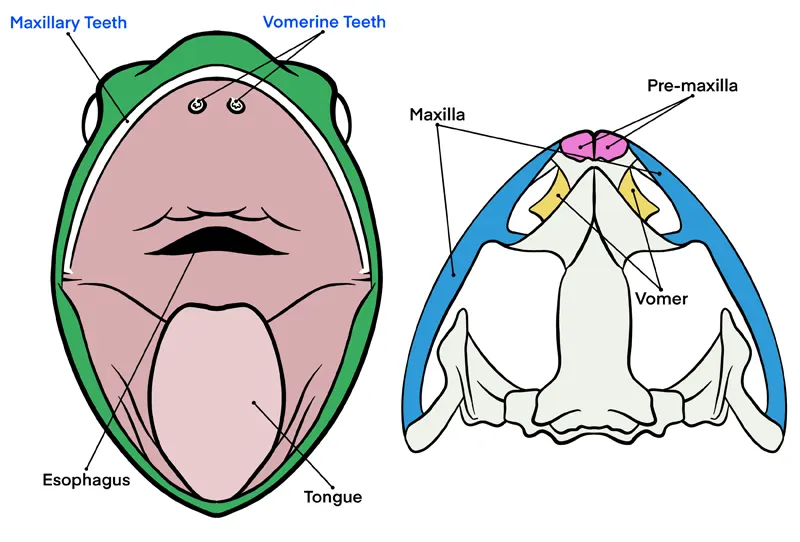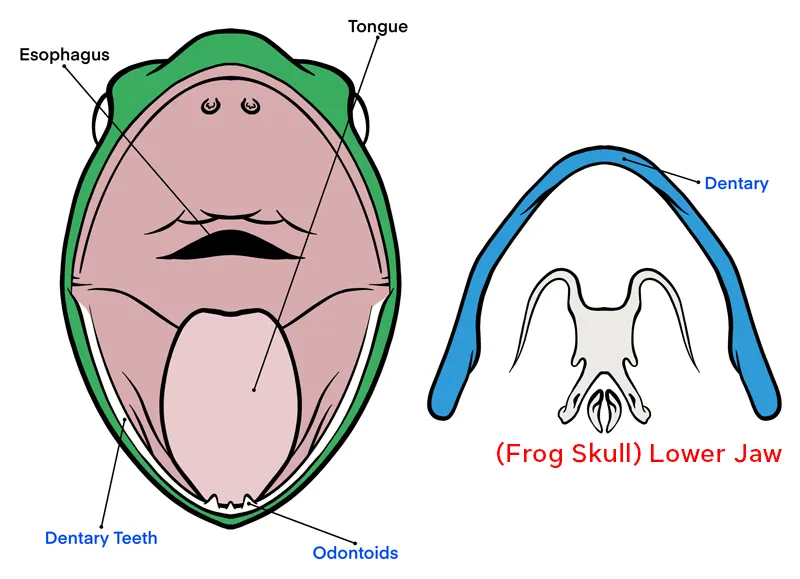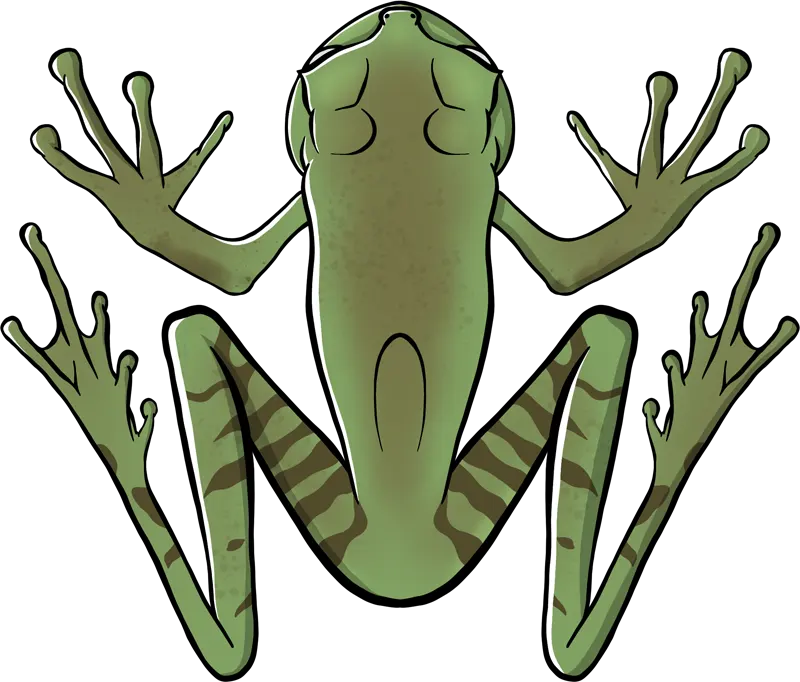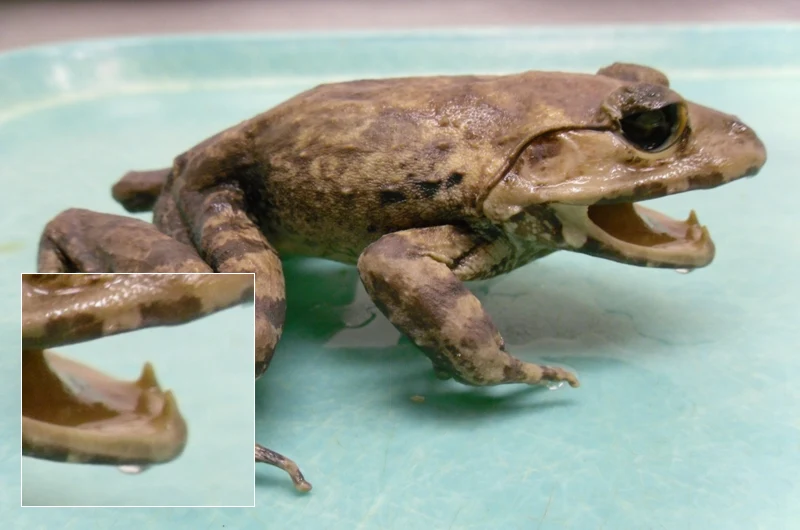Frog Teeth: Everything You Need To Know
At first glance inside a frog’s mouth, you might conclude they don’t have teeth. In some cases, you would be right. However, it may surprise you to learn that some frogs have teeth.
Even so, it’s nearly impossible to see frog teeth because they’re less than a millimeter in length. They’re known as maxillary and vomerine teeth, and they’re located on the upper jaw.
In rare cases, some frogs have fangs on the center of their lower jaw. They are easy to see. These fang-like structures are known as odontoids but they’re not considered true teeth. One species of frog has true teeth on its lower jaw.
Now that you’ve had a brief overview, let’s learn more about the different types of teeth frogs have.
Table of Contents
Types of Frog Teeth
Frogs with teeth typically have maxillary and/or vomerine teeth. These two are the most common kinds of teeth but there are exceptions.
The types of teeth some frogs have:
- Maxillary teeth (upper jaw)
- Vomerine teeth (upper jaw)
- Dentary teeth (lower jaw)
- Odontoids (lower jaw, not true teeth)
Let’s continue by learning more about each.
Maxillary Teeth
Maxillary teeth are located on the upper jaw [1]. They’re less than a millimeter long and located on the Maxilla bone.
To better understand Maxillary teeth, see the reference image below. Notice the Maxilla is a bone in the frog’s upper jaw. Furthermore, the Premaxilla bone is differentiated.

The number of maxillary teeth varies between species. European common frogs have around 30 teeth on the maxilla and 8 teeth on the premaxilla [2]. American bullfrogs have slightly more; between 60 – 70 maxilla teeth and 10 – 15 premaxilla teeth.
Vomerine Teeth
Vomerine teeth are located at the top of a frog’s mouth. See the reference image again for a better understanding of the vomerine teeth. Notice these teeth come from the vomer bone, which is different from the maxilla and premaxilla.
The number of vomerine teeth varies between species, too. European common frogs have 4 – 5 teeth per vomer. American bullfrogs have 5 – 10 teeth per vomer and northern leopard frogs have 4 – 5 teeth per vomer.
Dentary Teeth

Dentary teeth are located on the lower jaw, on the Dentary bone. There are over 7,000 frog species and only one has dentary teeth. In contrast, both salamanders and caecilians, the other two orders in class amphibia, have dentary teeth.
The one type of frog with dentary teeth is Gastrotheca guentheri, also known as Guenther’s Marsupial Frog. To learn more about Guenther’s Frog, continue reading in the “Frogs with Teeth” section below.
Odontoids
Odontoids are fang-like projections located on the lower jaw. While they’re not considered true teeth, one study recorded 11 species having odontoids on their mandibles [3].
The number of odontoids varies among the few species having them, but 2 to 3 are common. The development of odontoids is usually associated with hyperossification.
Hyperossification is the formation of more bone material than what is typical. This extra bone formation results in things like odontoids, thick skulls, and even small spikes protruding from the skull.
Related: Frog Skeleton: An Overview
Tooth Replacement: Shedding & Resorption
Tooth replacement in amphibians is still somewhat of a mystery but researcher are learning more every year. What they believe is that amphibians replace their teeth by means of resorption and/or shedding.
When a frog resorbs a tooth, it absorbes the minerals back into its body – much in the way tadpoles resorb their tails during metamorphosis.
Gillette found the entire tooth replacement cycle takes around 90 days[4].
Some studies suggests amphibian teeth are replaced over time, as they become worn down by regular use. Other research suggests tooth replacement occurs in patterns[5].
Until we learn more, it’s say to say that frogs replace their teeth occassionally.
Frogs With Teeth
Some frogs have teeth and some do not. Biologist Daniel Paluh and a team of researchers examined 524 amphibians. They found that all salamanders and caecilians had teeth. Meanwhile, 134 out of 429 frog species were toothless[6]. Out of the 429 frog species, maxillary teeth were present in 292 while vomerine teeth were present in 202.
Also, toads don’t have teeth. True toads are found in the Bufonidae family. Simply put, toads are a type of frog and they are toothless [7].
Frogs with teeth primarily use them to hold on to prey. They’re not used for chewing. A row of tiny teeth along their upper jaw helps them to keep crickets, spiders, worms, flies, and other insects in their mouth while they prepare to swallow. To recap:
- Some frogs have teeth. In a recent study, around 31% of the frogs had at least one type of teeth.
- Toads do not have teeth. True toads are those in the bufonidae family and they’re toothless.
- Frogs don’t use teeth for chewing. Instead, they’re used to hold on to prey before swallowing.
- Frog teeth are very small. They’re less than a millimeter in length.
- Some frogs have fangs on their lower jaw. They’re called odontoids but they’re not considered real teeth.
- One frog has teeth on its upper and lower jaw. The common name for this frog is Guenther’s marsupial frog.
Let’s continue by learning about a few special cases.
Guenther’s Marsupial Frog (Gastrotheca guentheri)

This is the only frog species with dentary teeth[8]. As we learned in a previous section, dentary teeth are located on the lower jaw.
Guenther’s frog is native to Colombia and Ecuador. Both males and females are similar in size, growing between 2.7 to 3.2-inches in length (snout to vent). Researchers believe this species re-evolved teeth after 200 million years[9].
Another interesting fact about Guenther’s marsupial frogs is that they don’t lay eggs in water, as with most frogs. There is a skin flap on their back in which they raise their young. Their tadpoles remain on their back until they’re froglets, at which time they venture out of the skin pouch.
Forked-Tongue Frogs (Limnonectes)

Southeast Asia is home to a group of frogs in the Limnonectes genus, many of which have fangs (odontoids)[10]. There are 77 species in the limnonectes genus at the time of writing this[11].
They’re commonly known as, “fanged frogs” [12]. Their fangs are located on either side of the tip of the lower jaw (dentary), with a smaller odontoid in the center.
African Bullfrog (Pyxicephalus adspersus)
African bullfrogs are one of the largest frogs in the world. They can weigh over 3 pounds and reach 9.6 inches in length. They’re both terrifying and cute at the same time.
They have large bodies that envelope much of their short, squatty legs. In addition to their size, they have thick fangs in the center of the lower jaw. Moreover, they can open their mouth wide. Wide enough to eat small mammals, reptiles, and other frogs.
Evolution and Tooth Loss in Frogs
A recent study examined the dental history of frogs from families within the order of Anura [6]. Anura, by the way, is the order in scientific classification containing all frogs and toads. The results revealed that frogs may have devolved teeth 20 times. Moreover, some species re-evolved teeth, as with the case of Guenther’s marsupial frog.
Toothlessness is often associated with a specialized diet. A diet consisting largely of small insects. However, not all amphibians have devolved teeth throughout history. In contrast, both salamanders and caecilians have teeth.
Still, the association of toothlessness with diet is aimed at very small insects like flies and ants. An example of this is frogs that primarily eat tiny flies. Teeth are not needed or used, as the frog is large enough to swallow the fly whole. The same concept can be applied to other small insects like ants and mites.
FAQs about Frog Teeth
This section is meant to answer some of the most common questions regarding frog teeth.
Yes, some frogs bite. However, most do not. They are more likely to run from confrontation. When threatened, some frogs won’t hesitate to deliver a bite. Pacman frogs are popular among amphibian hobbyists and they’re known to bite, whether they feel threatened or mistake their owner’s fingers for food.
No, frogs do not chew their food. Instead, they swallow it whole. Frogs with teeth merely use them to grip or hold their prey until they’re ready to swallow. Finally, frogs use their eyes to help them swallow food.
There are no known species of frogs that deliver venom via teeth or fangs.
Frogs are primarily carnivores, eating things like flies, bees, worms, isopods, beetles, ants, wasps, and true bugs. Large frogs and toads are capable of eating mice, other amphibians, crayfish, snakes, lizards, and fish.
TLDR; All About Frog Teeth
Some frogs have teeth, some don’t. The ones that have teeth typically have maxillary and/or vomerine teeth, which are located on the upper jaw. They’re small and nearly impossible to see with the naked eye.
The number of teeth varies between species. The American bullfrog, for example, may have 90 – 110 teeth while a European common frog has around 50.
Some frogs have fang-like structures known as odontoids. They’re not considered true teeth, but they’re similar in appearance. One species has teeth on its upper and lower jaw.
Finally, frogs don’t use their teeth for chewing. They’re used for holding on to prey.
References
- (Eng), Berkovitz Barry Bds MSc PhD Fds, and Peter Shellis. The Teeth of Non-Mammalian Vertebrates. 1st ed., Academic Press, 2016., pp. 113-152[↩]
- (Eng), Berkovitz Barry Bds MSc PhD Fds, and Peter Shellis. The Teeth of Non-Mammalian Vertebrates. 1st ed., Academic Press, 2016.[↩]
- Paluh, Daniel J., Edward L. Stanley, et al. “Evolution of Hyperossification Expands Skull Diversity in Frogs.” Proceedings of the National Academy of Sciences, vol. 117, no. 15, 2020, pp. 8554–62. Crossref, https://doi.org/10.1073/pnas.2000872117.[↩]
- Gillette, Roy. “The Dynamics of Continuous Succession of Teeth in the Frog (Rana Pipiens).” American Journal of Anatomy, vol. 96, no. 1, 1955, pp. 1–36. Crossref, https://doi.org/10.1002/aja.1000960102.[↩]
- Davit-Béal, Tiphaine, et al. “Amphibian Teeth: Current Knowledge, Unanswered Questions, and Some Directions for Future Research.” Biological Reviews, vol. 82, no. 1, 2007, pp. 49–81. Crossref, https://doi.org/10.1111/j.1469-185x.2006.00003.x.[↩]
- Paluh, Daniel J, et al. “Rampant Tooth Loss across 200 Million Years of Frog Evolution.” eLife, vol. 10, 2021. Crossref, https://doi.org/10.7554/elife.66926.[↩][↩]
- “Toothless Predator | AMNH.” American Museum of Natural History, www.amnh.org/exhibitions/frogs-a-chorus-of-colors/featured-frog-species/toothless-predator. Accessed 16 Mar. 2022.[↩]
- Paluh, Daniel J., et al. “Re‐evaluating the Morphological Evidence for the Re‐evolution of Lost Mandibular Teeth in Frogs.” Evolution, vol. 75, no. 12, 2021, pp. 3203–13. Crossref, https://doi.org/10.1111/evo.14379.[↩]
- Laurent, R. F. “Irreversibility: A Comment on Macbeth’s Interpretations.” Systematic Biology, vol. 32, no. 1, 1983, p. 75. Crossref, https://doi.org/10.1093/sysbio/32.1.75.[↩]
- STUART, BRYAN L., et al. “A New Fanged Frog in the Limnonectes Kuhlii Complex (Anura: Dicroglossidae) from Northeastern Cambodia.” Zootaxa, vol. 4894, no. 3, 2020, pp. 451–73. Crossref, https://doi.org/10.11646/zootaxa.4894.3.11.[↩]
- “Limnonectes Fitzinger, 1843 | Amphibian Species of the World.” American Museum of Natural History, amphibiansoftheworld.amnh.org/Amphibia/Anura/Dicroglossidae/Dicroglossinae/Limnonectes. Accessed 16 Mar. 2022.[↩]
- Herr, Mark W., et al. “A New, Morphologically Cryptic Species of Fanged Frog, Genus Limnonectes (Amphibia: Anura: Dicroglossidae), from Mindoro Island, Central Philippines.” Ichthyology & Herpetology, vol. 109, no. 1, 2021. Crossref, https://doi.org/10.1643/h2020095.[↩]
